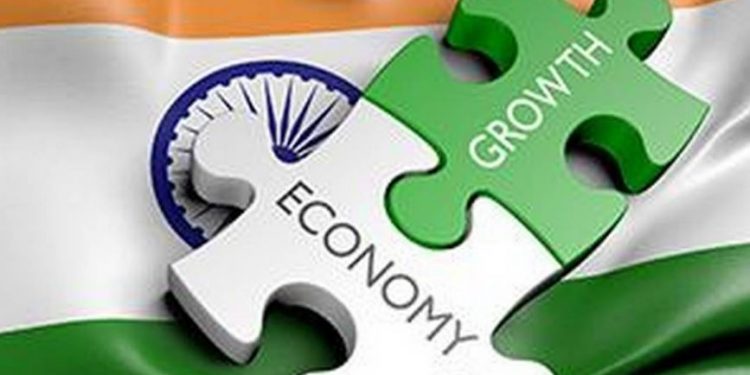New Delhi: Government officials Thursday went into a huddle to access the impact of Russian aggression in Ukraine on the Indian economy and began preparing contingency plans to combat a possible spike in inflation due to a rise in oil prices and the country’s external trade being impacted.
While there are no immediate fears of a supply disruption or trade routes being blocked, oil prices soaring to an over seven-year high of USD 105 per barrel do have a short and medium-term impact on the economy.
Finance Minister Nirmala Sitharaman said she will be meeting Prime Minister Narendra Modi to review the situation following Russian President Vladimir Putin authorising a ‘special military operation’ that saw his forces firing missiles at several cities in Ukraine and landing troops on its coast.
A daily revision in prices of petrol and diesel and the monthly change in cooking gas LPG rate was halted as five states including Uttar Pradesh went to polls. The over three-month hiatus combined with the spike in international oil prices — on which domestic rates are dependent — has widened the gulf between cost and selling price.
Industry sources said the gap is well over Rs 10 per litre, which when passed on after completion of the elections next month would result in a spike in inflation rate which is already above the RBI’s tolerance level of 6 per cent.
While the petroleum ministry detailed the oil supply situation, the finance ministry officials were busy assessing the broader impact and the fiscal measures the government may have to unleash, such as a cut in excise duty.
A separate assessment was being done on the impact of sanctions the US and other countries have imposed on Moscow, on India’s trade with Russia and Ukraine.
According to a senior finance ministry official, the government is assessing the economic fallout of the fast unfolding situation.
Inputs from various ministries are being gathered as to what impact sanctions will have on foreign trade in different sectors, the official said, adding crude oil prices are also being watched.
Another top official said oil supply routes are unhindered and there was abundant stock available in the market. “Our suppliers are in the Middle East, Africa and North America, who are untouched by the conflict and they continue to supply oil and gas as normal.”
Prices, however, are of concern as they will stoke inflation. “Retail prices are on hold but ultimately they will have to be increased at some point,” the official said.
India, the world’s third-largest oil consumer, depends on imports to meet 85 per cent of its needs. The imported oil is converted into products like petrol, diesel and LPG.
Saudi Arabia, Iraq and other Middle East nations account for 63.1 per cent of all imports. Africa is the second biggest supplier, accounting for close to 14 per cent of all supplies while North America gives 13.2 per cent.
Russia makes up for a third of Europe’s natural gas and about 10 per cent of global oil production. About a third of Russian gas supplies to Europe usually travel through pipelines crossing Ukraine.
But for India, Russian supplies account for a very small percentage. While India imported 43,400 barrels per day of oil from Russia in 2021 (about 1 per cent of its overall imports), coal imports from Russia at 1.8 million tonnes in 2021 made up for 1.3 per cent of all inbound shipments of the dry fuel. India also buys 2.5 million tonnes of LNG a year from Gazprom of Russia.
Exporters’ body FIEO said the Russia-Ukraine military conflict may have an implication on the country’s trade as it could affect the movement of consignments, payments and oil prices.
The Federation of Indian Export Organisations (FIEO) said it has asked exporters to hold their consignments to the region or goods that take the Black Sea route.
To Russia, Ukraine and other eastern European countries, goods move from the Suez Canal and the Black Sea, FIEO Director-General Ajay Sahai said.
Just about 1.6 per cent of all imports that came into India in 2020 were sourced from Russia and about 1.3 per cent of all exports from the country were destined for Russia. Similarly, India accounted for just about 1.5 per cent of all imports by Russia and about 1.7 per cent of all its exports.
Bilateral trade between India and Russia stands at USD 9.4 billion so far this fiscal, against USD 8.1 billion in 2020-21.
India’s main imports from Russia include fuels, mineral oils, pearls, precious or semi-precious stones, nuclear reactors, boilers, machinery and mechanical appliances; electrical machinery and equipment and fertilisers.
Major export items from India to Russia include pharmaceutical products, electrical machinery and equipment, organic chemicals and vehicles.
India’s bilateral trade with Ukraine is at USD 2.3 billion so far this fiscal, as against USD 2.5 billion in the last fiscal.
The main items of Indian import from Ukraine are agriculture products, metallurgical products, plastics and polymers, while pharmaceuticals, machinery, chemicals and food products are the major Indian exports to the country.
FIEO Vice-President Khalid Khan said if the military operation continues for a long time, it will have serious implications for exports to and imports from that region. “Oil and gas prices will zoom, there could be payment delays for traders,” he said.
Stock markets were awash in red and the Indian currency slumped against the dollar on Thursday amid Russia’s attack on Ukraine pushing investors to seek refuge in safe-haven assets.
PTI






































